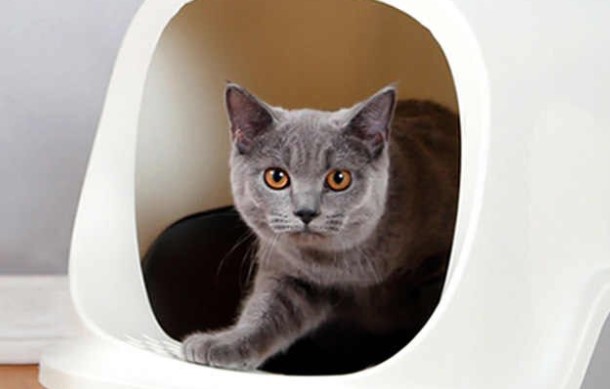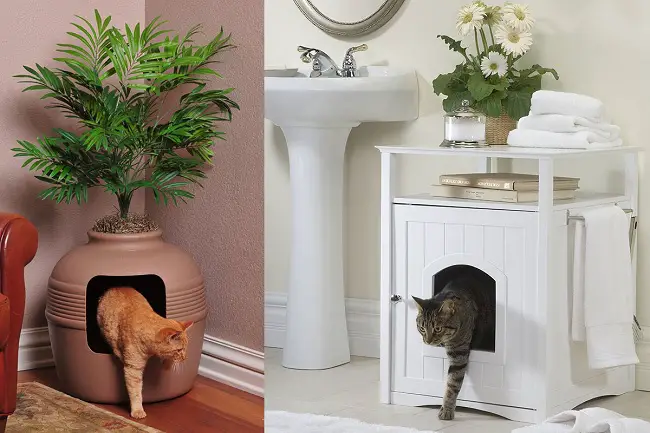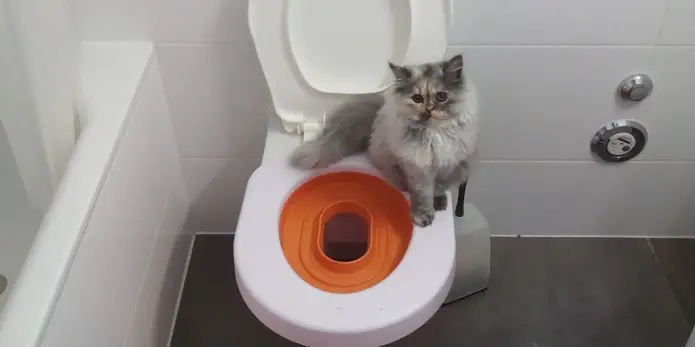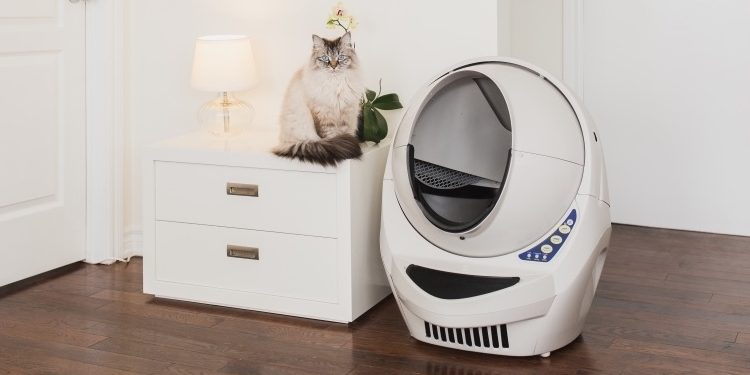Usually, domestic kittens learn to use the toilet by their mother’s example. This happens in the third or fourth week of life, and by the time of moving to new owners, the animal is already accustomed to the tray. But if you got the kitten earlier or you picked it up on the street, you will have to help the pet.
What do You Need to Know about Cat Litter Boxes?

Buy a Bigger Cat Litter Box
Your kitten will grow up quickly, and if one day the litter box is too small for him, the pet can go around the house to look for a more spacious toilet. In this case, the height of the sides should be such that the animal can climb into it on its own.
Please Note that Cat Litter Boxes can be Closed or Open
Both models have their pros and cons. On the one hand, the closed tray gives the animal a sense of privacy. On the other hand, the walls keep odors and the cat may refuse to use a tray that is not clean enough, in his opinion. In addition, it is not very convenient for large animals to turn around in such a tray and bury the traces of their vital activity.

Open trays also come in different types: with mesh, without mesh, with high and low sides. A high-edged tray is good for an adult who likes to dig too vigorously in litter and toss it in all directions. It will not be easy for a small kitten to get into such a tray at the training stage.
But a low tray with a mesh can be very useful. The filler in this model is poured under the removable part and does not come into contact with the paws. Perhaps your kitten will not immediately mind the net, and if it turns out that it is vital for him to rummage through the filler, the upper part can be removed permanently or temporarily.
However, such trays can be dispensed without fillers at all. You just need to pour out the urine and rinse the pot every time.
There are also special toilet seat covers that are good for everyone but one thing: they are not suitable for small kittens, pregnant cats, and old or sick animals. But if you really like the idea of toilet training and not fiddling with litter, you can try this when the kitten grows up.

Many of these covers are gradual toilet training systems, using rings of different diameters that are removed as the animal gets used to it. Some of them can be filled with the filler at first. Which system is right for your pet depends on his preferences.
Finally, there are fully automatic cat litter boxes that take care of themselves and are therefore very comfortable and hygienic. But such a miracle of technology is quite expensive. At the same time, there is a possibility that your pet will scare or simply dislike it.

Take Care of a Spare Cat Litter Box
This is not common but be prepared for the fact that some cats prefer to urinate in one litter box and have a large bowel movement in another. If you live in a house or apartment with several floors, a cat litter box should be available on each one.
And of course, if you have multiple cats, each should have its own litter box.
Choose a Suitable Location
The cat litter location should be easily accessible, comfortable, and fairly quiet. It is better not to put the tray in the farthest corner of the house: in case of emergency, the kitten may not have time to reach it.
What should be the filler
Choose a Filler that is Free of Dust, Lumps, and Odor
Today, in almost every pet store you can buy mineral, wood, corn, silica gel, and even paper fillers with a color indicator. In general, they all cope with their function, so the final choice depends on the personal preferences of the owner and the animal. But at the stage of potty training, it is worth paying attention to some important points.
It is recommended to use the litter, from which there is little or no dust, as it can cause discomfort in the kitten when inhaled. It is also not recommended to start toilet training with clumping mineral litter because your pet will almost certainly taste it, which can cause severe constipation.
Try to buy products from widely used brands. Perhaps your pet will get used to a certain type of granules and will refuse to use the toilet if suddenly the same filler is not in the store.
Silica gel filler may also not please you or the kitten, as it rustles quite loudly when buried. Fine corn filler sometimes even sticks to dry feet and spreads throughout the house.
It is better not to buy a litter with a smell, as a strong fragrance can scare the animal away and it will begin to look for an alternative place for the toilet.
Therefore, it is better to buy pressed sawdust as the first filler, and later, if you want, try other options.
Clean Your Cat Litter Box Regularly
If your kitten is just getting started toilet training, it makes sense to leave some wet litter or excrement in the litter tray as a reminder of where the toilet is in the house.
As soon as the animal gets used to it, everything will need to be cleaned, since a dirty pot can cause puddles and heaps in the wrong places. It is enough 1-2 times a day with a scoop to remove the used filler from the tray and sprinkle a new one in its place, plus once a week wash the container with warm water and a mild detergent without a strong odor.
If you have a double tray, remove feces from it regularly. If possible, wash the netting after each use of the toilet. Well, keep an eye on the cleanliness of the filler.
The toilet head should be cleaned and washed in the same way as a regular litter box at first. If you are using the toilet ring training system, there will soon be nothing to clean. The diameter of its rings gradually increases and as a result, the animal will learn to use the toilet without a nozzle.
How to Litter Train a Kitten
Put the kitten in the Litter Box
Let your baby get used to the smell and look around. Let the kitten sit or lie in the tray for a few minutes to get started. It’s okay if your pet doesn’t use the toilet immediately afterward.
Place the kitten in the litter box every time after eating, sleeping, playing, or if a long time has passed since the last departure. Also, immediately transfer the animal to the litter box if it crouched elsewhere with obvious intentions. Try to play with the kitten next to the pot: after jumping and somersaults, the pet will probably want to relieve itself.
Please be patient: some kittens understand why they need a litter box almost instantly, while others need a little more attention and reminders.
Keep Track of Feeding Times
Kittens usually need to relieve themselves about 20 minutes after eating. If you feed the kitten at the same time, you can predict when to enter the litter box.
Show the Kitten What to Do
If your pet has never seen a litter box, you will need to demonstrate to him clearly what to do with this item. Of course, you don’t need to use the tray in front of a shocked cat – just show that you can dig here. To do this, put the kitten in the tray and scrub the litter with your finger.
Never try to teach a kitten to dig by holding its paws. From this, he will only be frightened and next time he will bypass the side of the tray.
Praise and don’t Punish
Pet and talk affectionately with the kitten every time he shows interest in the litter box or uses it correctly. Do not shout, do not poke the animal with its muzzle, and do not hit it for misses: this will only achieve that the toilet will be associated with punishment and the pet will relieve itself in secret, hard-to-reach corners.
If the kitten leaves a surprise in the wrong place, transfer the pile to the litter box. This will remind the baby where to go to the toilet, and the smell will be associated with the pot.
Thoroughly Wash the Area of the Miss
To prevent randomness from becoming a pattern, remove all traces of hooliganism as soon as possible. It is imperative to get rid of the smell, otherwise, the kitten will consider this place as its permanent toilet.
Place Bowls of Food and Water in the Wrong Place
If the kitten has chosen a place that is completely not intended for this place for the toilet, rearrange food and water there. Instincts prevent cats from defecating near food and watering places, and your stubborn pet will be forced to abandon his dubious venture.

